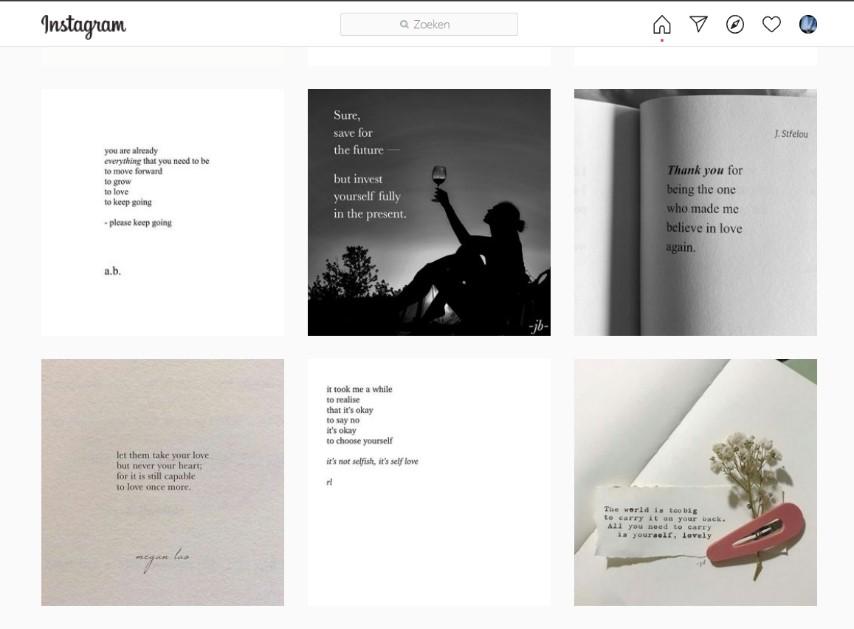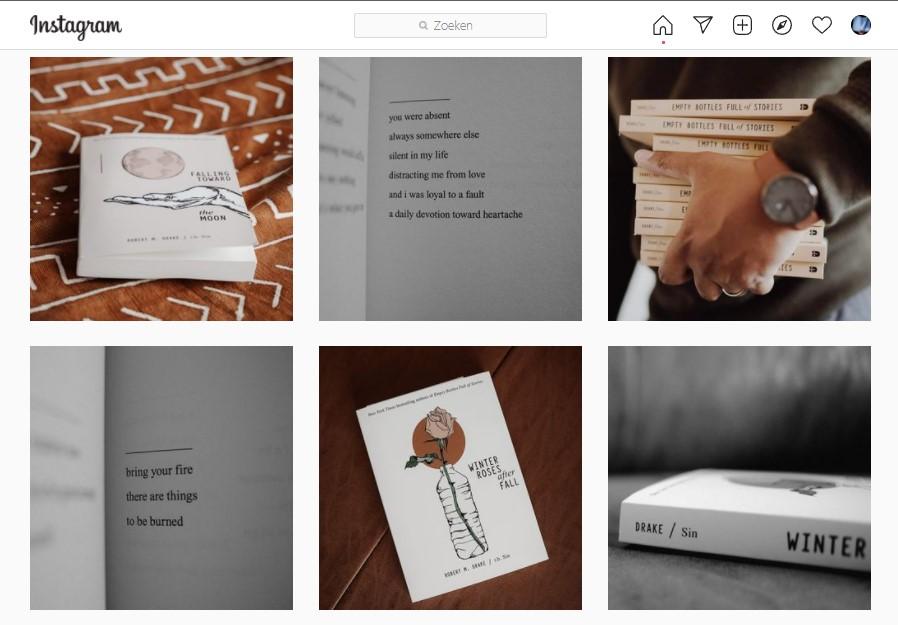
Instagram Poetry: Am I Good Enough for my Own Endeavor?
Until the 21st century, poems were mainly limited to books. Available to those who could afford the pages that were approved for publishing or had the opportunity to go to libraries. Alas, there is no need for this anymore, as one can open the screen in their hands and find the words of a poem at their fingertips. Perhaps you have been there too. Scavenging through Instagram at night, finding an abundance of poetry accounts. The Instagram poetry pages will provide a fresh poem for you every day, from old masters to trending young poets. The mix of old and new on one page gives the feeling the past and the present are talking to each other, being invited into the world that once was so untouchable. Poetry belonged to the elite and remains to carry the aura established by the past visions on it. Countless old poems will be glorified in a literature class. The words of the old masters carry notions hidden in a language that has evolved since then. A language that becomes increasingly tangible in current poetry which captures the melancholy of contemporary times with contemporary social issues. All are brought close through empirical visions of the writer aiming to establish a parasocial relationship with the devourer, the audience. Inevitably, the eyes of the restless soul of the reader grow tired from the light of the screen that dims, knowing that soon enough there will be more.
Instagram Poetry
In the world of Instagram, the picture in the background strengthens the notion of the message within the poem and invites you into the world of the author, even if it is for only a couple of lines. Simultaneously, the content creator is painstakingly aware of the affordances of the platform (DeVito, Birnholtz, & Hancock, 2017).

Screenshot made on 06/10/2021 of the Instagram page of @poets (@poets, 2021)
Instagram is a content-driven social media platform that thrives on aesthetic images. Consequently, it is commonly seen as a platform that displays conventionally beautiful people with attractive backgrounds. However, the platform has a large number of poetry pages to offer as pages of users are increasingly honing a niche, such as the poetry page shown in figure 1, in an attempt to separate themselves from the masses. However, often to no avail.
Regardless of its uniqueness in content, as opposed to the mean on Instagram, the page is always in a battle for attention with those making similar content. Therefore, in order to stay competitive and appear on the homepage of its followers, the page utilizes visibility labor (Rogers, 2021). Visibility labor is performed by users instigated by the effort a page makes to routinely post relevant content to keep its followers. Correspondingly, the Instagram algorithm decides how relevant the post is to the followers and boosts it accordingly. Thus, through the algorithm, the post of the page competes in an attention economy (Rogers, 2021; Abidin, 2016). Equally important to posting regularly to stay competitive is to post visual content. Since the algorithm favors imagery (visual content) over a picture with plain text. As a result, poetry pages have to create multimodal content, denoting that there is a combination of multiple manners of communication. In the case of the poetry pages, imagery - being the first manner of communication - is put in the background, and the text - being the second manner of communication - is in the foreground (Blommaert, 2005). Thus, the two components are creating multimodal communication to please the gatekeeper which is the algorithm (Noy, 2017).
The top 25 poetry accounts on Instagram are no strangers to the algorithms (Poetry, 2021). The pages create semiotic landscapes that are a slave to instagramism. The semiotic landscapes of the poetry pages are staged spaces that utilize technologies of communication such as pictures and texts, and they capture the multimodal means of signification in the environment (Jaworski & Thurlow, 2010).
Visibility Labor and Elitism
By conforming to the platform affordances, as well as the aesthetic of Instagram, the poetry pages can survive and thrive. As can be noticed, they all utilize a similar formula in the creation of their content and fall prey to looking alike, making the visibility of the page come down to the relatability of the writings and the regularity in the posting of content. The minute difference in posting and the necessary skill of one honing the classic white page with black text more than the other is crucial for gaining attention. Moreover, the overall empirical observations gathered from scrolling through the Instagram pages results in combination with analyzing the qualitative data shown below result in the recognition of the pattern of a play between the pictures with text and the white background with text. By showing the white page with the black text the poetry pages play into the semiotics of the glorified poetry of the past that carries a natural aura of elitism and reference to the books written poems were initially published in. This naturally carries over to the poetry of the present that is being shared on content-driven platforms like Instagram. The interplay between the two creates a balance between the elite aura poetry used to possess and the common of Instagram poetry that merely has the impression of elitism.

Screenshot made on 30/10/2021 of the Instagram page of @r.h.sin (@r.h.sin, 2021).
Nevertheless, due to the elements of elitism, such as exclusivity and the aura of luxury, it keeps the notion alive that poetry is for gifted children and adults that can use the language precisely, consequently connecting with each other through this practice. Therefore, it can largely be seen as a subculture that gravitates towards those who have a natural gift for language. It gives the impression that if you do not understand the poems, you are not part of the subculture. The exclusivity is an embodiment of elitism (Thurlow & Jaworski, 2021).
In contrast, poetry pages regularly display poetry that can be seen as “lazy” and “easily relatable” in order to attract a wider audience that does not want to put the effort into understanding (Warren, 2021). Naturally, this fits instagramism as it embodies the content that often encourages an act of mindless consumption. Regardless of this, poetry remains to have the aura of elitism. As the people who portray themselves on their poetry pages often dress in an academic or unique fashion that keeps their intangibility to the common consumers alive as they are unable to relate to the person portrayed. Additionally, this can be stated as a way in which the influencer portrays the idealistic poet (Jin, Muqaddam, & Ryu, 2018).
One can often wonder if they are worthy of this privilege, as nowadays it is not a matter of money, but of understanding and a feeling of belonging. Due to the elite image poetry has, it often feels like a betrayal of social status in consuming the content. Am I better than those who do not understand the melancholic notion that the poems provoke, or do I simply have the right combination of characteristics and education that allow me to grasp the meanings created between the lines? Or am I a victim of lazy poetry produced to be seen and understood by many? The internal conflict stirred by the perception of poetry as an elite practice illuminates how the perception of something as elite can be confronting to those who do not have the perception of themselves as such. This is regarded as elite discourse - while it is actually being hermetical, strange, and/or fascinating - through a public content-driven platform to show how identity performance through images goes beyond people in designer clothes or luxury locations. Instagram brings poetry back to an everyday matter that can be consumed easily and created without the need to be physically present.
The border of entry is low-lying on Instagram, so the mind has to establish its own border that is carefully crafted through symbolic violence. We regularly do not notice how our surroundings influence us and how we are guided by the perceptions of what is right and wrong through the environment. In the case of symbolic violence, the wrongdoing within the environment is so common to the individual that it is perceived as ordinary. Moreover, our environment is often linked to our social class (Wright, 2002). To combat this, the poetry pages on Instagram avoid sophisticated language, as well as complicated structures in the creation of the poetry. As a result, an increasing number of people can relate to the poetry and an increasing number of followers perform visibility labor, keeping the poetry page relevant to the algorithm.
While all this effort goes on in the background with the complex creations that are a slave to visibility labor and my inevitable internal battle with symbolic violence, I scroll through my homepage at night deciding if the poem speaks enough to me to press the like button. If I understand it enough to press this button in the first place. Seconds later, I move on to the next one. Scrolling habitually through my timeline. Vigorously pushing away from the doubts and finding comfort in the consumption of content that is perfectly tailored to my liking.
References
@poets. (2021, 10 06). Poets. Retrieved from Instagram.
@r.h.sin. (2021, 10 30). r.h. Sin. Retrieved from Instagram.
Abidin, C. (2016). Visibility labour: Engaging with Influencers' fashion brands and #OOTD advertorial campaigns on Instagram. Media International Australia , 86-100.
Blommaert, J. (2005). Discourse Analysis: A Critical Introduction . Cambridge: Cambridge University Press.
DeVito, M. A., Birnholtz, J., & Hancock, J. T. (2017). Platforms, People, and Perception: Using Affordances to Understand Self-Presentation on Social Media. The Presentation of Self in Everyday Media, 740-754.
Jaworski, A., & Thurlow, C. (2010). Semiotic Landscapes. London, New York: Continuum International Publishing Group.
Jin, S. V., Muqaddam, A., & Ryu, E. (2018). Instafamous and social media influencer marketing . Social media influencer marketing, 567-579.
Noy, C. (2017). Ethnography of Communication . Ashkelon Academic College, 1-11.
Poetry, P. M. (2021, 10 30). The Top 25 Instagram Poetry Accounts. Retrieved from Pick Me Up Poetry.
Rogers, R. (2021). Visual media analysis for Instagram and other online platforms. Big Data & Society, 1-23.
Thurlow, C., & Jaworski, A. (2021). Elite mobilities: the semiotic landscapes of luxury and privilege. Social Semiotics, 487-516.
Warren, D. (2021, 09 18). fine, let's talk modern poetry. Retrieved from YouTube.
Wright, E. O. (2002). Pierre Bourdieu on Social Class and Symbolic Violence. In P. Bourdieu, Alternative Foundations of Class Analysis (pp. 116-166).